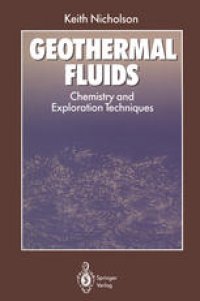
Ebook: Geothermal Fluids: Chemistry and Exploration Techniques
Author: Dr. Keith Nicholson (auth.)
- Tags: Mineralogy, Geophysics/Geodesy, Geology, Mineral Resources, Soil Science & Conservation, Renewable and Green Energy
- Year: 1993
- Publisher: Springer-Verlag Berlin Heidelberg
- Edition: 1
- Language: English
- pdf
This book introduces aqueous geochemistry applied to geothermal systems. It is specifically designed for readers first entering into the world of geothermal energy from a variety of scientific and engineering backgrounds, and consequently is not intended to be the last word on geothermal chemistry. Instead it is intended to provide readers with sufficient background knowledge to permit them to subsequently understand more complex texts and scientific papers on geothermal energy. The book is structured into two parts. The first explains how geothermal fluids and their associated chemistry evolve, and shows how the chemistry of these fluids can be used to, deduce information about the resource. The second part concentrates on survey techniques explaining how these should be performed and the procedures which need to be adopted to ensure reliable sampling and analytical data are obtained. A geothermal system requires a heat source and a fluid which transfers the heat towards the surface. The fluid could be molten rock (magma) or water. This book concentrates on the chemistry of the water, or hydrothermal, systems. Consequently, magma-energy systems are not considered. Hot-dry rock (HDR) systems are similarly outside the scope of this text, principally because they contain no indigenous fluid for study. Both magma-energy and HDR systems have potential as energy sources but await technological developments before they can be exploited commercially. Geothermal systems based on water, however, are proven energy resources which have been successfully developed throughout the world.
This book provides a comprehensive introduction to the chemistry of geothermal water and gas discharges, including the application of isotope studies, and assumes no prior knowledge of geothermal fluid chemistry. The critical interpretation of discharge chemistry in terms of resource evaluation and the development of hydrological models are emphasized. The text is divided into two parts: following an introduction to the genesis of geothermal fluids, the first part deals with water, gas and isotope chemistry. The chemical behaviour of common constituents and the interpretation of the chemical signature of the fluids are discussed, with stress placed on the evaluation of reservoir conditions and subsurface flow regimes. The second part describes techniques in geochemical exploration for geothermal resources. Individual chapters deal with the planning, execution and critical evaluation of water, gas and soil surveys. Analytical methods, units and data presentation techniques are also covered in this section. Both students and experienced geothermal scientists will find this book of value both as an introductory text to the application of geothermal chemistry, and as a reference handbook to geochemical techniques. Part Two will also be of interest to exploration and environmental geochemists in general, as the survey techniques detailed have applications beyond geothermal resource evaluation